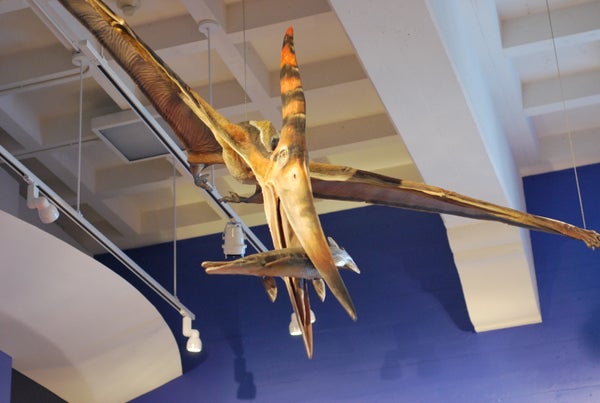This article was published in Scientific American’s former blog network and reflects the views of the author, not necessarily those of Scientific American
For animals that spent their days soaring through the Mesozoic skies, pterosaurs have spent a lot of time in the shadows of the dinosaurs. They’re an essential part of most any Mesozoic scene - just like a mammal in the underbrush or a monkey puzzle tree in the background - but quite often they’re treated like a kind of ancient window dressing for the main dinosaurian show. I’m not immune to this. I know because a paper titled “Pterosaur dietary hypotheses: a review of ideas and approaches” made me realize that I don’t know very much about what these leathery-winged wonders actually ate. Neither, it turns out, do paleontologists.
Even though pterosaurs “were integral components of continental and marginal marine ecosystems” Jordan Bestwick and colleagues write at the top of their paper, “their diets remain poorly constrained.” In other words, we’re often left with more assumptions than hard evidence. Small, toothy pterosaurs have often been assumed to be insect-snatchers, for example, while large, toothless forms are often characterized as fish-eaters. Those are fair guesses, but we need a bit more to back up or refute those old characterizations.
Evidence for what prehistoric creatures ate falls along a broad spectrum. Finding gut contents or food scraps in fossil poop are the most direct, but trace fossils, isotopic analysis, and biomechanical studies also have their roles to play. The strongest cases can be made when these various points can be integrated, but even that can be a challenge with a fossil literature spread far and wide over two centuries. To that end, Bestwick and colleagues combed through 126 studies documenting 314 dietary interpretations for pterosaurs to sift through what we think about pterosaur diets and where the evidence stands.
On supporting science journalism
If you're enjoying this article, consider supporting our award-winning journalism by subscribing. By purchasing a subscription you are helping to ensure the future of impactful stories about the discoveries and ideas shaping our world today.
Some of the team’s conclusions had to do with how science is carried out. In their review, Bestwick and colleagues found that most inferences about pterosaur diets came from comparative anatomy. For example, the now-dispelled idea that toothless pterosaurs in seaside settings were like giant versions of black skimmers, or that because the needle-toothed grin of Dimorphodon resembles that of some bug-munching bats that the pterosaur was probably an insectivore, as well. And even though paleontologists have been studying pterosaurs since the mid-19th century, the vast majority of hypotheses about pterosaur diets - 73.8% of the sample - have been published in the last 18 years.
But what about what pterosaurs actually ate? Sometimes the connections are fairly direct. The pterosaur Eudimorphodon ranzii was found with fish scales in its gut contents, and specimens of Rhamphorhynchus muensteri have been found with fish and invertebrates inside them. Pterosaurs with gut contents are rare, though, and just because one species was found with a particular morsel doesn't mean the snack was a dietary staple or can be taken as a rule for other species.
The jaw and tooth anatomy of other pterosaurs leaves little doubt that they fed on different diets. The problem is that what Bestwick and coauthors call “content fossils” - closely connecting pterosaurs and what they ate - are only mentioned in about 5% of dietary interpretations. Most dietary reconstructions - over 60% in the study - are based on comparative anatomy but usually without additional evidence to test or back up the idea. This doesn’t necessarily mean that ideas based on comparative anatomy are inherently wrong, but that it’s a weak form of argument that requires additional evidence and testing.
The overall picture is murky. Bestwick and colleagues note that there seems to be consensus for some groups - paleontologists are generally agreed that the tiny, bat-like anurognathids ate insects and that pteranodontids were fish eaters - but the fact of the matter is that we have little to no idea what most pterosaurs were feeding on or how they fit into the broader ecological networks of which they were a part. This gap has as much to do with history and the quirks of the fossil record as anything else. Pterosaur skeletons were so fragile that they can be difficult to find, and for most of the 19th and 20th century it was the discovery and description of new species, rather than biological interpretation, that was the primary focus behind their study. It’s only been recently, as new technologies have allowed new investigations into pterosaur biomechanics and ecology, that questions of how these animals actually lived have started to come to the forefront.
Looked at one way, this could be taken as a down beat. We hardly know pterosaurs at all. We’ve cataloged plenty of species, with more named every year, but understanding how they fit into the Mesozoic world has eluded us. But the good news is that we are now at a time when multiple lines of evidence can be assembled to begin weaving a clearer picture of how these prehistoric flyers behaved. Geochemical clues about diet, engineering analyses of how jaws worked, and high-definition CT scans of teeth can be matched with trace fossils, gut contents, and details of ancient ecosystems to narrow the field and at least assemble a possible range of diets for pterosaurs. As we learn more, I can only expect that pterosaurs will follow a similar path to dinosaurs - they are going to become stranger than we ever anticipated.
